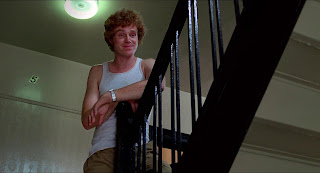On Criterion, I watched the 1980 film Cruising, written and directed by William Friedkin, based on the novel by Gerald Walker, and starring Al Pacino, Paul Sorvino, and Karen Allen. The film is notorious for having been protested by the LGBTQ+ community, because it is about a cop named Steve Burns (Pacino) on an undercover assignment to go into gay leather bars in the West Village and Christopher Street area to find a serial killer that has been targeting gay men, and using him as bait because he matches the slim, dark-haired look of his victims. The film depicts gay men as victims, murderers, and into the S&M scene, and given that so little of mainstream Hollywood at the time would depict queer characters in a more well-rounded way, it's understandable that the gay community would be against it. The film is largely seen through the straight cisgender lens, of the straight cop being internally weirded out by seeing public gay sex and kinky club scenes, and whenever he comes home and has sex with his girlfriend (Allen), who is unaware of the nature of his assignment, it's like he's trying to prove his straightness and quickly shed his gay cover identity.
It's an interesting movie, and outside of the straight male lens of the film, it's unique to see a movie capture the sense of the gay leather bar scene of downtown NYC, trying to show as much as they could of the sexuality without getting an X rating, and showing a glimpse of the gay scene before the AIDS crisis would take over and change the whole cruising scene afterwards. The film incorporates elements of the giallo horror genre, and Friedkin slipped in quick cuts from gay pornography during the film's first murder scene, that can be seen when the film is slowed down, a la Tyler Durden's projector trick in Fight Club.
Friedkin had stated that he was originally interested in Richard Gere for the lead, and that while he was satisfied with Pacino's performance in retrospect, he felt like Pacino was uncomfortable with the overtly queer scenes, while Pacino has said that he didn't know what Friedkin wanted from him as an actor, and the film is left open-ended with a finale with his character that doesn't seem to make a lot of sense, and could be interpreted a couple of ways. I do agree that I can see Gere fitting in, as he would have a rough trade, hustler look circa 1980, and would blend in more in the scene than Pacino does, whose eyes often make him look more nervous and out of place.
I liked the supporting performances of Don Scardino as a struggling gay playwright who is Burns' neighbor, more of a shy, quiet guy in contrast to the more sexually assertive characters in the cruising scene, and James Remar as the playwright's boyfriend, who only appears in one scene but stands out with a lot of screen presence and boldness. I was surprised to see Ed O'Neill in an early role as a cop, as well as William Russ as the killer's friend, Mike Starr as a cop, Maniac director Joe Spinell as a cop, and Powers Boothe as a salesman.
I liked seeing Karen Allen, but felt her character was very one-dimensional and underused. She's just cast as the worried girlfriend, either getting pounded in a sex scene, or saying cliched lines like "Are you still attracted to me?" or "I feel like I don't know you anymore," stuff that just makes her character look boring and shafted off to the side. It's a thankless role, and luckily she would get a much meatier part in 1981's Raiders of the Lost Ark as Marion, the hard-drinking adventurer by Indiana Jones' side.
The gay community of the West Village circa 1979 would protest the film by purposely disrupting filming with pointing mirrors to mess up lighting shots, blasting whistles and air horns, and playing loud music. The audio would have to be overdubbed to remove the distractions from people off-camera. Also, gay-owned businesses wouldn't allow filming on their premises, and real leather bars wouldn't allow their places to be used, so the film would make up a club but use real patrons from gay bars as extras for authenticity.
The film is accurate in depicting police brutality and the targeting of queer people by the cops, and how corrupt and awful it is. The film has an early scene with two cops (Spinell and Starr) in their car harassing two transwomen sex workers, and making them get in their car and perform sex acts on them. Then one of the women, when she tries to tell a cop (Sorvino) what happened later, is not believed and ignored. The film also has an interrogation scene where, while Burns is undercover and had been arrested with a potential suspect, are both beaten by a 6'5 man in a jockstrap, who just seemingly is on retainer by the police for this one task, and the suspect, a young gay man who looks more like a kid, is humiliated by the police, and is obviously not the killer. The police later dismiss a murder of a gay man as a "lover's quarrel." The film is honest about the police being abusive and corrupt, and no punishment comes to them, as unfortunately would be likely in real life.
It's not the kind of movie I would watch again, and it is limited by being a movie about gay life through the eyes of straight men, but I felt like it was an interesting cop thriller to watch that felt very much of its time.




No comments:
Post a Comment